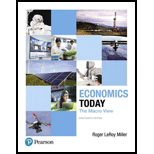
Whether a nation will experience an inflationary gap or recessionary gap due to a sudden decline in the real interest rates
Concept introduction:
Aggregate
Real
Inflationary gap: Inflationary gap is the excess of actual aggregate supply over potential aggregate supply. It arises when AD exceeds full-employment AS.
Recessionary gap: Recessionary gap is the excess of potential aggregate supply over actual aggregate supply. It arises when AD falls short of full-employment AS.
Real Interest Rate (r): r is the interest rate actually earned on deposits by depositors or paid on loans by borrowers. It is adjusted for inflation.
Want to see the full answer?
Check out a sample textbook solution
Chapter 11 Solutions
Economics Today: The Macro View (19th Edition) (Pearson Series in Economics)
- The first question, the drop down options are: the US, Canada, and Mexico The second question, the drop down options are: the US, Canada, and Mexico The last two questions are explained in the photo.arrow_forwardcheck my answers, fix them if they are wrong. everything is in the picture. the drop down menus are either kansas or Illinois, except the last one which is yes or no.arrow_forwardeverything is in the imagearrow_forward
- everything is in the image!arrow_forwardRespond to isaiah Great day everyone and welcome to week 6! Every time we start to have fun, the government ruins it! The success of your business due to the strong economy explains why my spouse feels excited. The increase in interest rates may lead to a decline in new home demand. When mortgage rates rise they lead to higher costs which can discourage potential buyers and reduce demand in the housing market. The government increases interest rates as a measure to suppress inflation and stop the economy from growing too fast. Business expansion during this period presents significant risks. Before making significant investments it would be prudent to monitor how the market responds to the rate increase. Business expansion during a decline in demand for new homes could create financial difficulties.arrow_forwardPlace the labeled CS to represent the new consumer surplus in the market and the area labeled PS to represent producer surplusarrow_forward
- Not use ai pleasearrow_forwardNot use ai pleasearrow_forwardRespond to Luis Rodriguez I recommend Mrs. Ibrahim's proposal to lower interest rates as the more effective approach for fostering economic growth in Sudan. Sustainable Growth - Lowering interest rates encourages investment in productive capacity, which can lead to long-term economic growth rather than a temporary boost from cash transfers. Job Creation - This approach can create more stable employment opportunities by promoting business expansion through lower borrowing costs. Addressing Structural Issues - Lower interest rates can help address underlying structural issues in the economy, such as low production levels, by incentivizing businesses to invest in technology and infrastructure. Inflation Control - While there is a risk of inflation if appropriately managed, focusing on productive investments can help mitigate this risk compared to the potential inflationary effects of direct cash transfers. In conclusion, while both proposals have merit, Mrs. Ibrahim's approach of…arrow_forward

 Principles of Economics (12th Edition)EconomicsISBN:9780134078779Author:Karl E. Case, Ray C. Fair, Sharon E. OsterPublisher:PEARSON
Principles of Economics (12th Edition)EconomicsISBN:9780134078779Author:Karl E. Case, Ray C. Fair, Sharon E. OsterPublisher:PEARSON Engineering Economy (17th Edition)EconomicsISBN:9780134870069Author:William G. Sullivan, Elin M. Wicks, C. Patrick KoellingPublisher:PEARSON
Engineering Economy (17th Edition)EconomicsISBN:9780134870069Author:William G. Sullivan, Elin M. Wicks, C. Patrick KoellingPublisher:PEARSON Principles of Economics (MindTap Course List)EconomicsISBN:9781305585126Author:N. Gregory MankiwPublisher:Cengage Learning
Principles of Economics (MindTap Course List)EconomicsISBN:9781305585126Author:N. Gregory MankiwPublisher:Cengage Learning Managerial Economics: A Problem Solving ApproachEconomicsISBN:9781337106665Author:Luke M. Froeb, Brian T. McCann, Michael R. Ward, Mike ShorPublisher:Cengage Learning
Managerial Economics: A Problem Solving ApproachEconomicsISBN:9781337106665Author:Luke M. Froeb, Brian T. McCann, Michael R. Ward, Mike ShorPublisher:Cengage Learning Managerial Economics & Business Strategy (Mcgraw-...EconomicsISBN:9781259290619Author:Michael Baye, Jeff PrincePublisher:McGraw-Hill Education
Managerial Economics & Business Strategy (Mcgraw-...EconomicsISBN:9781259290619Author:Michael Baye, Jeff PrincePublisher:McGraw-Hill Education





